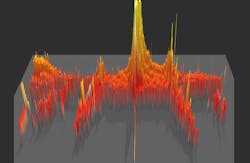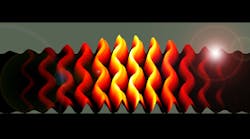New work on breathing soliton lasers by a team of scientists, including Professor Junsong Peng at the East China Normal University in Shanghai, recently led to the discovery of a novel route to chaos (see video).
Solitons are localized wave packets that propagate without changes in dispersive/diffraction mediums, thanks to balance between dispersion/diffraction and nonlinearity. Lasers that can emit these wave packets are called soliton lasers and are the building blocks of many photonics systems such as light detection and ranging (LiDAR), femtosecond pulse generation, and optical communications—to name merely a handful. Solitons are extremely convenient platforms to explore fundamental science.
“We’re interested in studying the nonlinear dynamics of soliton lasers, because understanding these nonlinear dynamics is not only crucial to design better laser sources but also conducive to many physical systems—solitons are universal within science and nature,” says Peng.
Peng and colleagues previously demonstrated in 2023 that a soliton laser can be used to explore synchronization phenomena via two competing frequencies inside the laser (see below).
Related Article
“One is the repetition frequency of the solitons (cavity repetition frequency) determined by the length of the laser. A second one refers to the energy variation of the solitons: under certain conditions, the energy of the soliton isn’t constant but self-modulated (breathing solitons),” Peng says.
Synchronization occurs when the ratio between the two frequencies is rational. Otherwise, it’s unsynchronized. The synchronized state is a subharmonic state because the energy variation of solitons (breathing frequency) is a subharmonic of the cavity repetition frequency.
“Recently, we discovered breathing solitons (subharmonic) can be further self-modulated in a new state called a ‘modulated subharmonic state,’” Peng explains. “Our most recent work shows that such a new state can lead to the generation of chaos. It’s a new route to chaos.”
What is laser chaos?
Laser chaos refers to the extreme sensitivity of nonlinear systems to initial conditions, in which small changes to initial conditions can trigger disorder and massive chain reactions.
“Chaos theory was proposed by American meteorologist Edward Norton Lorenz during the early 1960s,” says Peng. “He used a vivid metaphor to describe the phenomenon of chaos, the famous butterfly effect: If a butterfly in the Amazon River Basin flaps its wings, the small airflow changes it causes may become a tornado in Texas two weeks later. And the ancient Chinese saying: ‘Even the slightest difference can lead to a thousand miles of error,’ can also be regarded as a vivid description of chaos.”
The group’s design work shows precisely the new route to chaos they observed. In the beginning, only a single frequency—the subharmonic frequency—is present, and sidebands (the modulated subharmonic state) appear after increasing the pump current. This results in so many frequencies that it creates a very broad spectrum, which signals chaos is being generated.
“First, we’d like to emphasize that although the route to chaos is universal, we found an unexpected new modulated subharmonic route to chaos,” says Peng. “Second, our work extends laser chaos from the Maxwell-Bloch equations to the framework of the generalized nonlinear Schrödinger equation.”
Since the latter equation is universal, the group’s new route to chaos can be widely studied within relevant systems. “The benefits of such an extension are twofold: On one hand, it enables spontaneous generation of laser chaos purely from nonlinear dynamics of solitons—without use of external signals (the current laser chaos generation relies on external signal injection), which greatly simplifies generation of laser chaos,” says Peng. “On the other hand, compared to standard laser chaos, laser soliton chaos is localized and attractive for many practical applications.”
The biggest challenge involved for the group’s experiments and simulations was that “it’s quite time-consuming to find the target chaotic laser regime because there are multiple ‘knobs’ within the laser, and chaos is only generated when all the knobs are turned to the right values,” says Peng. “It’s not easy to confirm the laser state’s chaotic. We need data analysis tools to confirm its chaotic nature.”
Soliton lasers enable chaos
Many real-world systems can switch to chaos from a stable state by tuning the system’s control parameter. From physical and biological to chemical systems, the route to chaos is universal.
“Currently, there are three universal routes to chaos within rather different systems, including the Ruelle-Takens scenario (quasi-periodicity route), the Feigenbaum scenario (period-doubling route), and the Pomeau-Manneville scenario (intermittency route),” explains Peng. “No matter how different the systems are, the route to chaos is nevertheless similar. But our work shows a new route to chaos, which is very surprising.”
During the group’s experiments, they expected to observe undocumented routes to chaos within the laser. “But in most cases, like other systems, the routes to chaos within the laser obey the three universal routes to chaos without exception,” says Peng. “Since the modulated subharmonic state is a new dynamical state, we wondered whether it could lead to chaos.”
Indeed, they discovered this new state leads to chaos by tuning the knob within the laser. “Since chaos signals a broad and noisy radio spectrum evolving from a narrow one (akin to an exploding process), it felt like a flash exploding within our hearts to observe such a fascinating process,” Peng says. “A new door has opened for us to explore chaos via soliton lasers.”
Expand the range
The experimental research on chaotic solitons is still in its infancy, but several directions can be pursued now. “From a fundamental perspective, observing new routes to chaos is of great importance to nonlinear science so we’re trying to see whether this new route is also present within relevant systems,” says Peng.
Beyond its significance in fundamental science, soliton chaos shows potential for many applications. “It’s inherently localized and can extend the application areas of chaos theory,” Peng points out.
And since chaos exists only within a narrow range of the laser parameters, “it’s beneficial to expand its range so chaos can be readily generated within a laser,” Peng adds. “Since optical chaos is widely used within many photonics systems, our new soliton chaos is expected to improve their performance by virtue of its localization and broadband.”
FURTHER READING
H. Kang et al., Phys. Rev. Lett., 133, 263801 (Dec. 26, 2024); https://doi.org/10.1103/physrevlett.133.263801.
X. Wu, J. Peng, S. Boscolo, C. Finot, and H. Zeng, Phys. Rev. Lett., 131, 263802 (Dec. 29, 2023); https://doi.org/10.1103/physrevlett.131.263802.
About the Author
Sally Cole Johnson
Editor in Chief
Sally Cole Johnson, Laser Focus World’s editor in chief, is a science and technology journalist who specializes in physics and semiconductors.



